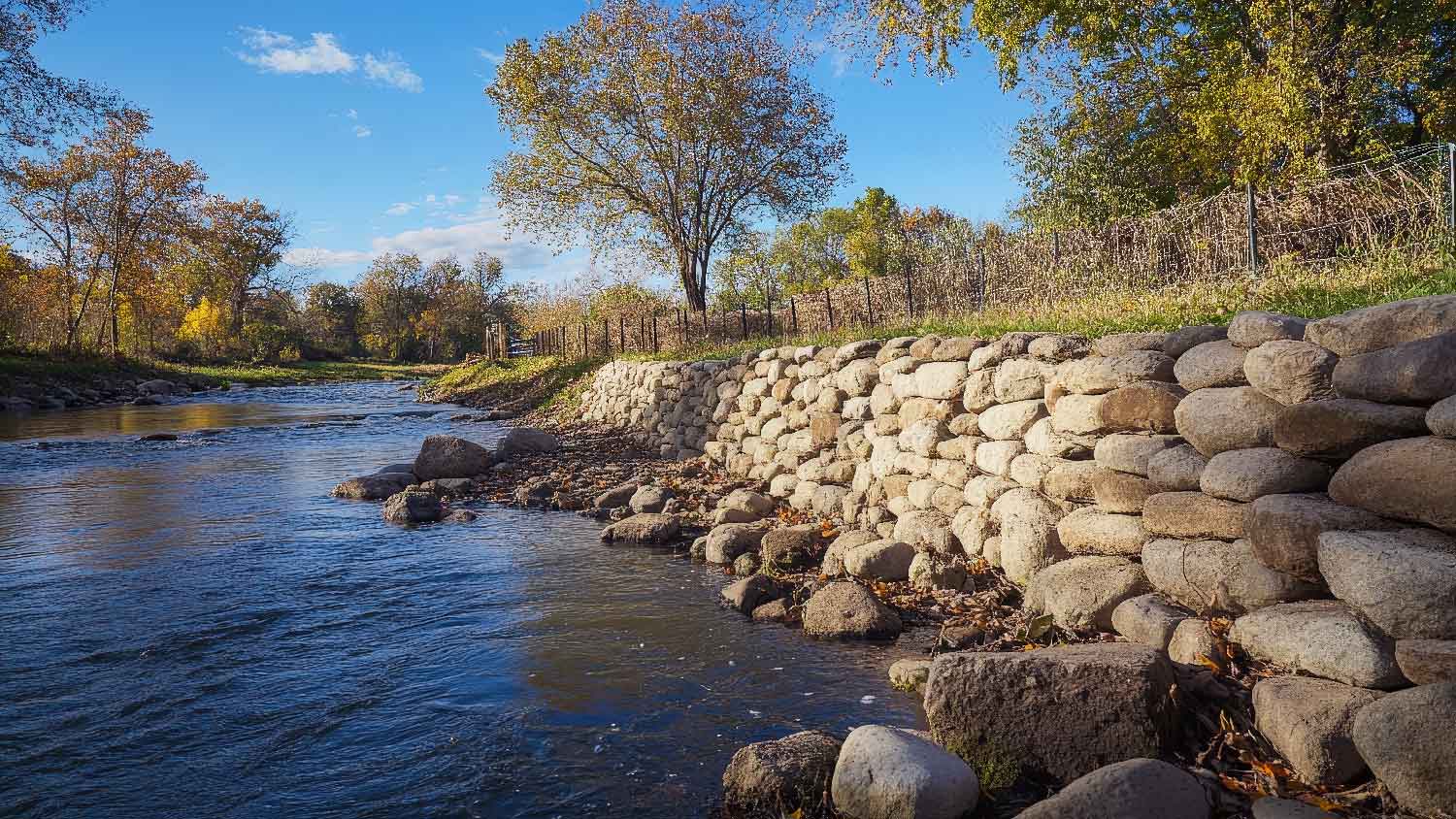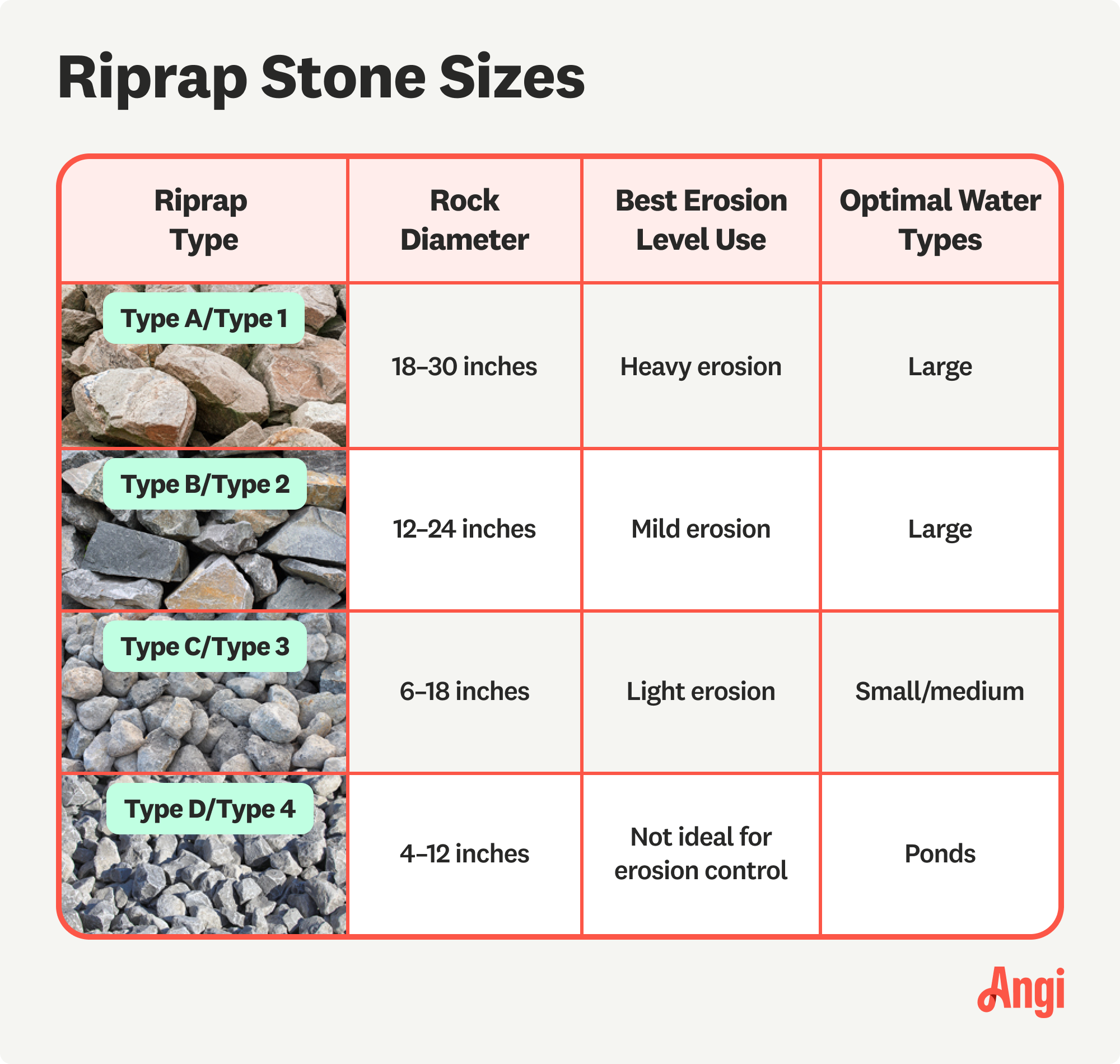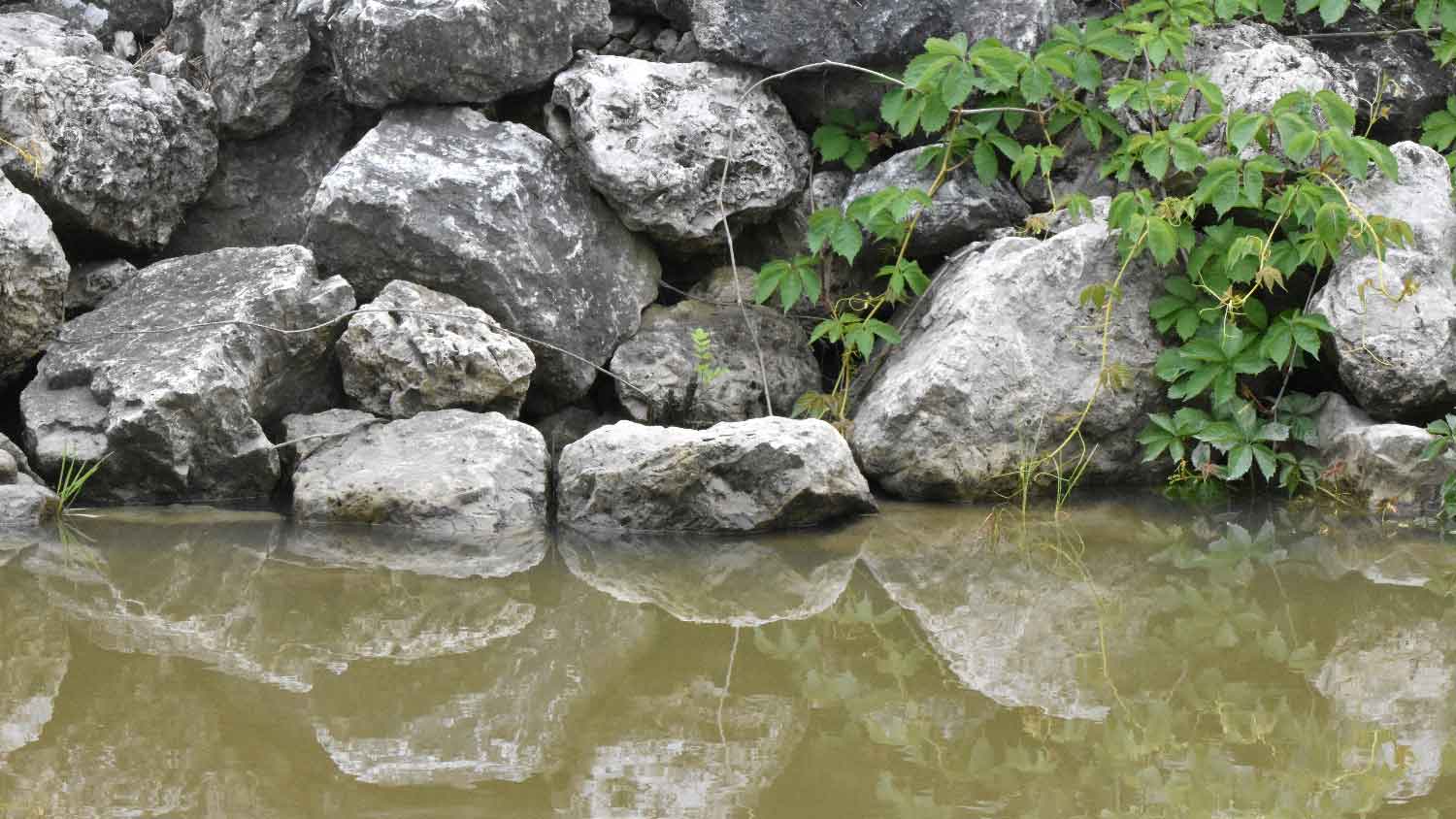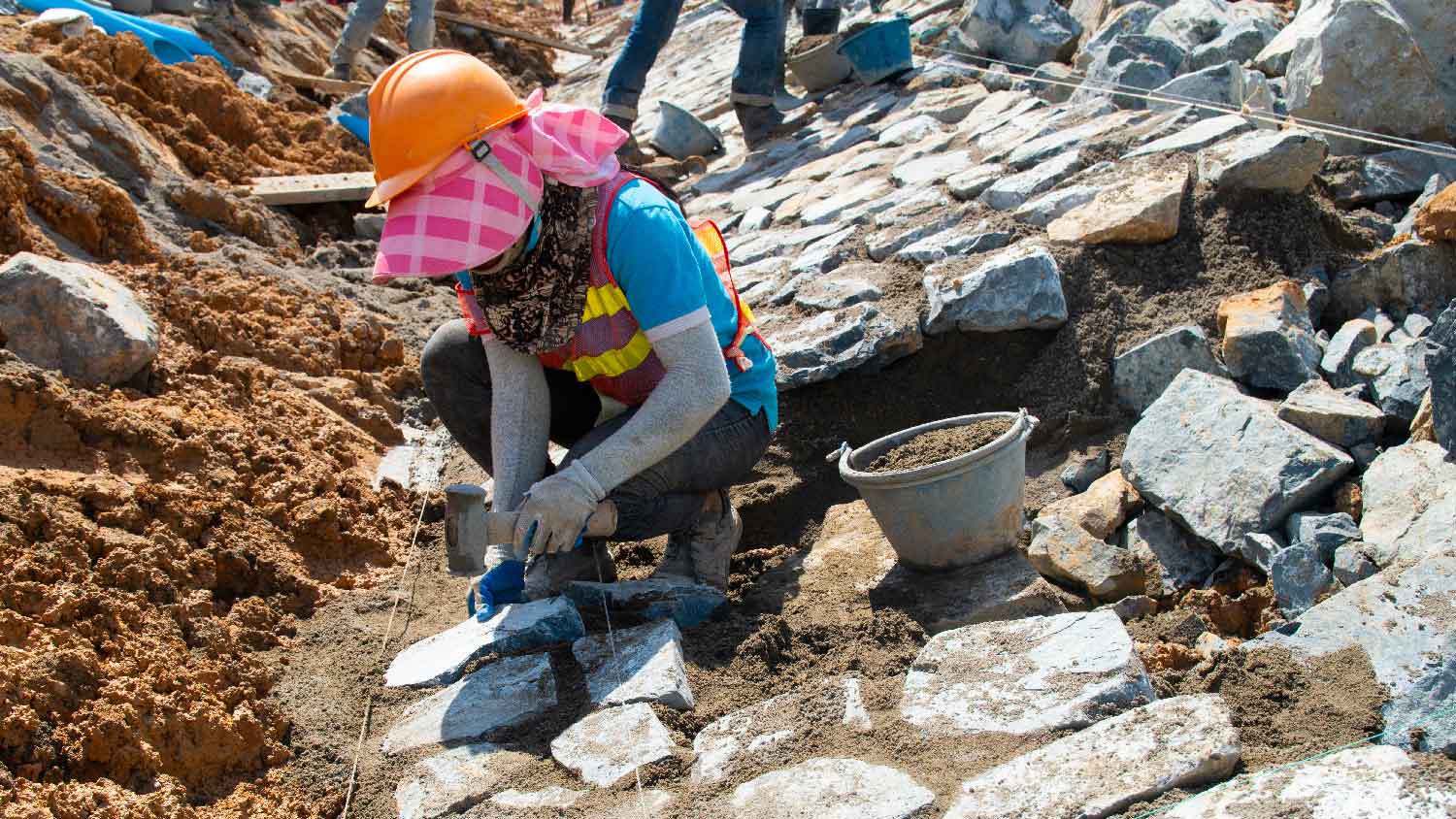How Much Does Riprap Cost? [2025 Data]
Installing riprap costs $20,000 on average. The total often ranges from $10,000 to $30,000 depending on rock type, quantity, shoreline length and width, and other factors. Get in touch with a pro for a unique quote that takes your property into consideration.


Riprap costs an average of $20,000, but the project may range from $2,200 to $120,000 depending on the size and type of riprap, the size of the site, the complexity of the shoreline, and other factors. Homeowners can expect to spend $70 to $400 per linear foot, with most projects ranging from 100 to 300 linear feet. By investing in riprap, you’ll add a low-maintenance, long-lasting erosion control solution to your property line.
Riprap Cost Factors
Although the average riprap installation project costs $20,000, the total can vary widely depending on the property, the amount and type of riprap needed, the location, prep work, and more.
Riprap Type and Size

Riprap is made with fieldstone, quarry stone, granite, or limestone in a variety of sizes that are ideal for different purposes.
| Riprap Type | Description | Cost per Cubic Yard |
|---|---|---|
| Fieldstone | Smooth and rounded | $65–$105 |
| Quarry stone | Coarse and angular | $75–$175 |
| Granite | Flat, irregular shapes | $65–$100 |
| Limestone | Heavy and angular | $85–$105 |
Shoreline Size

The size of the shoreline, or how much riprap you need, will be a major factor in the cost of installation. Riprap may be sold by the ton or cubic yard, while the project total may be measured in linear feet. Ultimately, this cost depends on the length, width, and depth of the shoreline and the amount of riprap needed to cover that space.
| Measurement | Cost |
|---|---|
| Per ton | $20–$110 |
| Per cubic yard | $70–$750 |
| Per linear foot | $70–$400 |
Materials
Riprap installation costs start at $2,200 just for materials, but because this isn’t a DIY-friendly project, it’s important to factor in both material and labor costs.
For riprap, you’ll pay for the rocks as well as for the fabric or other matter placed under the riprap to protect the soil and keep the rocks in place. The underlayment cost will vary by the size and weight of the fabric, but in total, it can cost $45 for a small, 40-foot-long roll to over $3,050 for a heavy-duty, 300-foot roll.
All materials considered, you’ll pay the following averages for each ton of riprap.
| Amount in Tons | Coverage in Square Feet | Average Cost |
|---|---|---|
| 1 | 20–90 | $20–$110 |
| 2 | 40–180 | $40–$220 |
| 3 | 60–270 | $60–$330 |
| 4 | 80–360 | $80–$440 |
| 5 | 100–450 | $100–$550 |
Labor
You may need to work with several different experts, including drainage pros and structural engineers, to install riprap. Riprap costs $70 to $400 per linear foot, which includes both materials and labor.
Hiring a structural engineer costs $200 to $1,500 total, while hiring drainage pros for installation costs $50 to $300 per hour. You may also pay different rates depending on whether you have the riprap installed randomly or hand-placed.
| Installation Type | Average Cost per Linear Foot |
|---|---|
| Random | $70 |
| Hand-placed | $750 |
Prep
Surveys, assessments, excavations—oh my! There is a lot of prep work that goes into installing riprap, especially for larger projects along a lake, river, or ocean. The prep can cost $3,900 to $27,700 alone. This includes $800 to $5,500 for a site survey, $1,500 to $15,000 for an environmental impact assessment, and up to $6,700 for excavation costs (which will be even higher if the pros need to use barges over excavators due to a difficult-to-access site).
The design and permit process will require several inspections, and you’ll need to pay for site surveys and environmental impact assessments to make sure that riprap is the best erosion solution for the site and that the project won’t disrupt the local ecosystems.
Location
The more difficult it is to access the shoreline, the higher the riprap installation cost will be. Expect to spend $400 per linear foot for shorelines with several trees, steeper slopes, or larger bodies of water with higher wave energy. That being said, installing riprap along larger lakes or on oceanfront properties costs more than installing riprap along smaller bodies of water.
Permits
Building permits cost $525 to $3,050, and these are required for you to begin installation. Because riprap installation involves working near a body of water, including lakes or oceans, permits often come at a higher cost and require multiple site inspections.
Ongoing Costs for Riprap

Riprap is a durable, easy-to-maintain material that will help protect your home and property from erosions and flooding. However, it does require some TLC, including regular weeding around the area, annual inspections, and other ongoing time and money costs to consider.
Maintenance
Fortunately, riprap is a low-maintenance erosion control tactic, meaning you won’t spend much to keep it in good condition. Aside from occasional repairs, maintenance consists of weeding the area and keeping any plants with extensive root systems from growing near the riprap. Weed pulling costs $30 to $300 per every 1/4 of an acre.
Repairs
With constant exposure to water and the elements, riprap requires repairs from time to time. Plan to inspect the length of the riprap-covered shoreline at least once per year as well as after any major weather events, like a storm or flood.
Major storms can damage riprap, and repairing the seawall costs $100 to $250 per linear foot. Make sure to handle repairs ASAP, or you risk further damage to the entire installation.
Insurance
Your waterfront home may come with stunning views and endless recreational activities, but it’s important to maintain the riprap and insure your home in the event of erosion or flooding. Regular home insurance costs $900 to $1,800 per year but doesn’t always cover flooding. You’ll need to purchase hazard insurance, which costs an additional $1,250 to $1,650 annually.
DIY Riprap Installation vs. Hiring a Pro
Riprap installation, especially for a shoreline, is not a DIY project. Improper riprap installation can lead to negative environmental impacts that ripple far beyond your property, not to mention that the riprap could fail, leading to erosion and flooding that destroys your property.
Always work with a drainage pro near you to make sure your riprap installation is safe and effective.
Cost of Common Riprap Add-Ons
When installing riprap, there are several other projects to consider that can make your waterfront property more accessible and attractive. From building a dock for fishing or boating to refreshing the entire landscape around your home, here are some other projects to consider when installing riprap.
Dock installation cost: $4,000–$26,000
Landscaping cost: $1,250–$6,300
Water feature installation cost: $950–$5,000
Outdoor lighting cost: $3,000–$6,000
Pond maintenance cost: $450–$5,000
Tips to Reduce Riprap Cost
Riprap is a high-cost project, and it’s essential to invest in high-quality, durable rock that’s professionally installed in order for the project to properly limit erosion, minimize flooding risks, and keep your property stable and resilient.
Still, there are a few ways to lower the cost of installing riprap.
Consider stone costs: While you want to opt for durable stones, you can reduce the project total by opting for lower-cost stones over the most expensive options.
Explore installation types: If your site allows, you could save hundreds of dollars per cubic foot with random installation over hand-placed riprap.
Check for tax credits: There aren’t federal tax incentives for residential erosion control. However, some municipalities and states may offer tax credits for riprap installation or other erosion control projects.
How Angi Gets Its Cost Data
Home is the most important place on earth, which is why Angi has helped more than 150 million homeowners transform their houses into homes they adore. To help homeowners with their next project, Angi provides readers with the most accurate cost data and upholds strict editorial standards. We extensively research project costs to develop the pricing data you see, so you can make the best decisions for you and your home. We rely on reputable sources, including the U.S. Bureau of Labor Statistics, academic journals, market studies, and interviews with industry experts—all to ensure our prices reflect real-world projects.
Want to help us improve our cost data? Send us a recent project quote to costquotes@angi.com. Quotes and personal information will not be shared publicly.
Frequently Asked Questions
One disadvantage of riprap is that it is limited to less steep slopes. If the slope into the shoreline is greater than 2:1, the riprap can slide or fall out and stop being effective. Another disadvantage is that adding riprap can limit access to the shore from your property since these rocks aren’t safe to walk on.
Riprap is made from sturdy, durable rocks, so it lasts 70 to 100 years once installed. However, the longevity of riprap depends on proper installation. Working with engineers and drainage pros for riprap installation is essential for your project to last for several decades. Improper installation can cause the rocks to come loose and will fail to promote drainage and protect the area from erosion.
A pro will install a specialized fabric, aggregate material, or other small, granular material to help prevent soil erosion. The riprap and underlying layer of material work together to keep nearby water from pulling soil into the water. This minimizes erosion and better protects your property from flooding when the water level rises due to precipitation and storms.





- Landscapers
- Tree Surgeons
- Gardening Services
- Landscape Architects
- Sod Installation
- Tennis Court Contractors
- Landscape Design
- Retaining Wall Companies
- Grading Companies
- Landscape Rock & Sand Delivery
- Mulch Delivery Services
- Pond Companies
- Artificial Grass Companies
- Shrub Removal & Trimming
- Backyard Design Companies
- Commercial Landscaping
- Koi Pond Services
- Backyard Landscapers
- Trampoline Assembly
- Hedge Trimming
- Pond Services
- Garden Design
- Outdoor Plant Watering
- Putting Greens
- French Drains
- Turf Installation
- Sod Removal Services
- Lawn Repair Services
- Brush Chipping Services
- Hardscape Contractor
- Landscape Rock Removal










